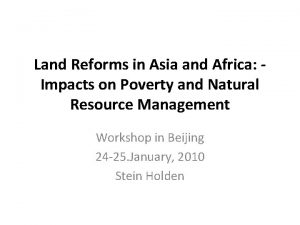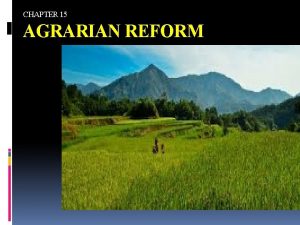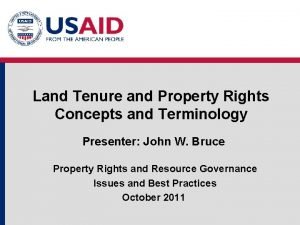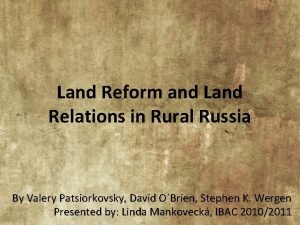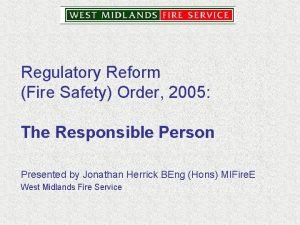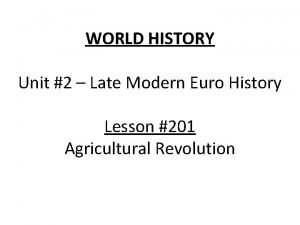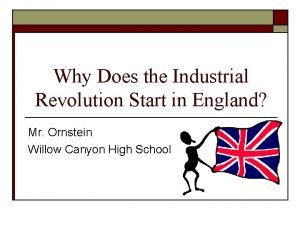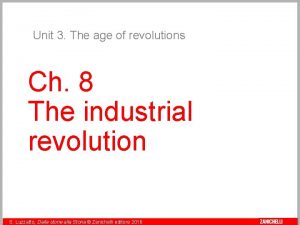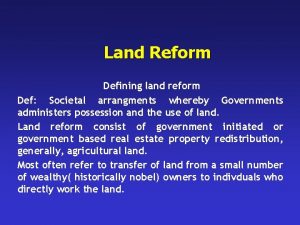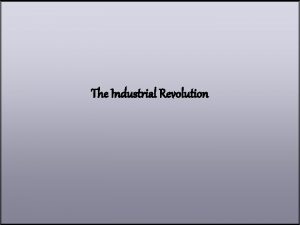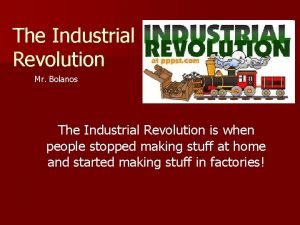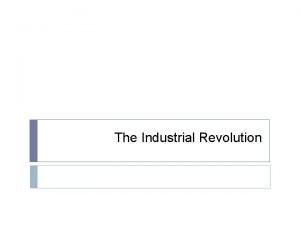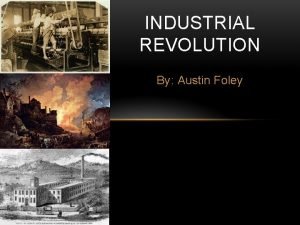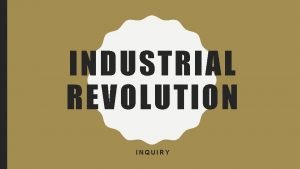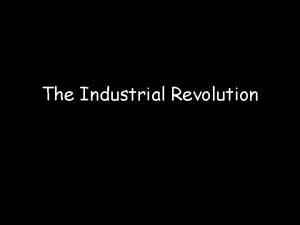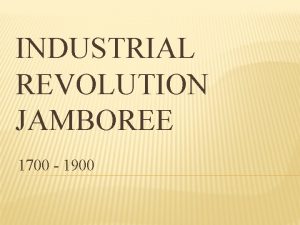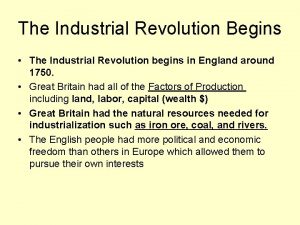The Industrial Revolution Land Reform The Old Order
























- Slides: 24

The Industrial Revolution Land Reform

The Old Order: Feudalism* • What happened to the land determined the life and death of humans • Land was owned by the king (monarchy) • Lords were granted land for services (usually military) – Did not owned the land – Merely managed the land • Lords divided land among lesser lords who managed the land the serfs • Many serfs were oppressed and forced into labor • The surfs would give up a large percentage of their crop to their lord who in turn would contribute to those further up the command chain • In exchange serfs were entitled to protection including enough food to survive, fuel, housing and pasture for their animals * Feudalism as an economic system as opposed to the political system

The Developing Order: Capitalism • Privatization of land had begun around 1800 and continued well past the 1848 political revolutions of Europe • By legal action ownership of the land was transferred into the hands of profit-pursuing private enterprises. • By this process land was turned into commodity that can be sold to maximize its productivity • Under the new system land was owned by the capitalist farmers (lords) and worked by hired laborers (serfs) • Privatization improved efficiency and reduced demand for labor • This new class of country laborers had no safety net provided to them in this new system. • Many were jobless and hungry, which forced them into the industrializing towns at a rate faster than towns could expand

The Role of Agriculture • In the developing order, agriculture was prepared to carry out five fundamental functions in the era of industrialization: – Increase production and productivity – Provide a large and rising surplus of potential recruits for towns and industries – Provide a mechanism for the accumulation of capital to be used in more modern sectors of the economy – Create a sufficiently large market among the agricultural population – Provide an export surplus to insure capital imports

The Industrial Revolution The Rise of Capitalism

Growth of the Textile Industry • The British textile industry represented the first wave of capital investments by those who gained from trade and agriculture • The textile industry was the first to develop for several reasons; – Colonial trade created it and continued to nourish it – Plantations in the Southern United States used slave labor to supply cotton cheaply – Inventions increased efficiency in both cotton and textile production (higher output meant lower prices) – Large domestic and overseas markets and increased production insured superb return on investment encouraging even more (exported 13 yards of cloth for 8 used at home E=200 m, R=529 m)

From Rags to Riches in the Textile Business • An ex-drapers assistant like Robert Owen could start with £ 100 of borrowed money in Manchester in 1789 and buy out his partners in the New Lanark Mills for £ 84, 000 in cash by 1809 • By comparison, around 1800, less than 15% of the population earned more than £ 50/yr and of these less then 25% earned more than £ 200/yr

The Rise of Capital • Small savings and small loans with healthy returns made some entrepreneurs very wealthy who became members of the middle class (bourgeoisie) • Gains in the textile industry increased the amount of capital, still in shortage as a whole • This imperfect flow of national investment created pockets of wealth and poverty

“Boom” and “Bust” • Thrifty, self-made industrialists were looking for ways to reinvest their profits • As the textile industry matured reducing profitability, investing was increasingly more difficult and less attractive • The middle class held on to large amounts of capital not seeing investment opportunities • Low levels of capital investment led to a general economic downturn which devastated the poor • Economic movements were no longer controlled by good or bad harvest, rather by the movements of capital investments • In part, the 1848 revolutions across Europe were ignited as a direct result of inequities built into the developing system of capitalism

The Laboring Poor • During periods of “boom” the poor suffered because of the exploitative nature of the industrial capitalist • During periods of “bust”, the poor suffered because of high unemployment • The bourgeois motto “every man for himself and the devil take the hindmost” did not appear to serve the greater good • “men have invented excellent arts to weaken and undermine one another’s livelihood” • In bourgeois society, this left the working poor with three alternatives: – Strive to become bourgeois – Allow themselves to be exploited – Rebel

Attempts to Deal with Problems • Thomas Malthus – Poverty is unavoidable – Population grows faster than food supply • David Ricardo – Forced attempts like minimum wage to fix the problem is futile – Interference would cause false security – Feeling of security would signal people to have more children, problem would get worse • Jeremy Bentham – Goal of society is to bring “greatest happiness for the greatest number” – Government should get involved as necessary to increase happiness and minimize suffering • John Stuart Mill – Government can rightfully exercise power over any member to prevent harm to others – Called for giving the vote to workers and women as to exercise political power to win reforms • Robert Owen – Utopian communities where work was to be shared and property owned in common • Adam Smith – The free market (unregulated exchange of goods and services) would come to help everyone • Karl Marx – “Scientific socialism” where an inevitable power struggle would lead to common ownership of productive assets by the working class in a classless society

Malthusian Basic Theory Population Growth (Labor) Unsustainable Population Resource Growth (Land) Ideal Population Growth (Labor) Constant Population Declining Population (Labor)

Factors of Production • Land – All natural resources used to produce goods and services • Labor – Workers who devote effort to a task for which they get paid • Capital – Savings used to invest in production of goods and services • Entrepreneurs – People who combine land, labor, and capital to produce goods and services for a profit

The Important Role of Capital • Production is the function of the right mixture of land, labor, and capital • With a growing population, labor grows faster than land (resources) and capital • Colonies provided land (resource) growth • Technology has the same affect as resource growth • Profits provided capital stock, which was still in short supply • To better the conditions of the working class capital stock must increase to match the increase in labor • Capital grows fastest when profits are the greatest • Profits are greatest when market forces prevail • Market forces prevail without government interference

Factories 1. Population is 100 workers 25 W 2. 2 factories are open for production 3. Each factory employs 25 workers 25 W 4. Pool of unemployed is 50 5. Wages are low due to competition among workers 6. Workers are exploited by industrialist 7. Profits are high because costs are low 8. Capital stock grows because profits are high

Factories 1. Population is 100 workers 25 W 2. 4 factories are open for production 3. Each factory employs 25 workers 25 W 4. Pool of unemployed is 0 5. Wages are fair due to reduced/no competition among workers 6. Profits are high but upward pressure on prices begin to show 7. Capital stock grows because profits are still high

Factories 1. Population is 100 workers 15 W 2. 5 factories are open for production 3. Each factory employs 25 workers 20 W 19 W 21 W 4. Pool of unemployed is 0 5. Demand for labor is higher, but supply of labor is unchanged 6. There is a shortage of 25 workers 7. Wages are increasing as industrialists compete to attract workers to their factory 8. Profits are reduced because the cost of production increased 25 W 9. Capital stock growth slows because profits are reduced

The Industrial Revolution The Transportation and Communication Revolution

Investment in Transportation Creates Another Boom • In 1830, only a few dozen miles of railway existed in the world, most between Manchester and Liverpool • The British had invested in 23, 500 miles of railway by 1850; this amounted to £ 240 million • The average investor only gained 3. 7% on money invested, while promoters and speculators did exceedingly well • Each mile of railway track required 300 tons of iron not including bridges • British iron and coal output tripled between 1830 and 1850 to meet demand

New Investment Opportunities • Profitable investments in the railway increased capital stock • Technological advances provided new investment opportunities for profit seekers – Nikolaus Otto invented the internal combustion engine – Karl Benz built first automobile – Henry Ford mass produced Model T on an assembly line (division of labor) – Wright brothers built first airplane – Samuel F. B. Morse developed the telegraph – Alexander Graham Bell patented the telephone

The Industrial Revolution Profits Soar, Population Grows Faster, Poor Get Poorer

The Rise of Big Business • New technologies required the investment large amounts of capital • To raise needed capital entrepreneurs formed giant corporations • Businesses sold shares of stock to investors who would then become part owners • Owners would share the profits • With large amounts of money businesses attained large market power in their industry and monopolies were born

Monopolies • Monopolies destroyed competition • Without competition monopolies could raise their prices to increase profits • Monopolies invested large amounts of capital and employed thousands of workers which added to the general prosperity • Monopolies, however, damaged the free enterprise system which led to questionable business practices and a push for government interference • Big business found support from many government leaders

Population Grows • Between 1800 and 1900 the population of Europe more than doubled • Population growth was caused by a rapidly declining death rate aided by medical advances • Germ theory identified the causes of infections disease • Vaccines were discovered to protect against microbes • Cities grew larger and taller as more people came looking for employment opportunities • Population grew faster than cities could expand • Slum conditions remained as cities became divided between “good” west end and “poor” east end
 Land reform definition
Land reform definition Societal def
Societal def Geography grade 12 settlement questions and answers
Geography grade 12 settlement questions and answers Diosdado macapagal agrarian reform
Diosdado macapagal agrarian reform Ano ang land tenure reform law tagalog
Ano ang land tenure reform law tagalog Land reform
Land reform Pangulo sa ikatlong republika
Pangulo sa ikatlong republika Form 1 land registration reform act
Form 1 land registration reform act Revolution brings reform and terror
Revolution brings reform and terror Chapter 7 section 2 revolution brings reform and terror
Chapter 7 section 2 revolution brings reform and terror Chapter 23 section 2 revolution brings reform and terror
Chapter 23 section 2 revolution brings reform and terror 1st order 2nd order 3rd order neurons
1st order 2nd order 3rd order neurons Regulatory reform fire safety order 2005
Regulatory reform fire safety order 2005 Regulatory reform fire safety order 2005 summary
Regulatory reform fire safety order 2005 summary Ingegneria sicurezza antincendio
Ingegneria sicurezza antincendio Regulatory reform (fire safety) order 2005 article 8 to 23
Regulatory reform (fire safety) order 2005 article 8 to 23 What are landforms
What are landforms Grassland landforms
Grassland landforms Russian revolution vs french revolution
Russian revolution vs french revolution How could the french revolution been avoided
How could the french revolution been avoided The third agricultural revolution
The third agricultural revolution Describe the causes of french revolution
Describe the causes of french revolution Enclosure movement
Enclosure movement Why did the industrial revolution start in britain
Why did the industrial revolution start in britain Zanichelli
Zanichelli
